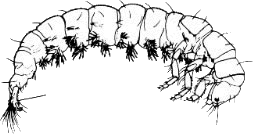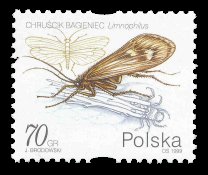Trichoptera
Pronunciation: [Tri⋅COP⋅ter⋅a]
Pronunciation: [Tri⋅COP⋅ter⋅a]
Common Name: Caddisflies
Greek Origins of Name: Trichoptera, derived from the Greek words “trichos” meaning hair and “ptera” meaning wings, refers to the long, silky hairs that cover most of the body and wings.
Holometabola, i.e. complete metamorphosis (egg, larva, pupa, adult)
Common worldwide. Larvae are aquatic and may be abundant in some cool, fresh water habitats. Adults are less conspicuous, usually nocturnal. Approximately 28 families and 1,500 species in North America and 43 families and ~14,000 species worldwide.
The order Trichoptera (caddisflies) is another likely descendant of the Mecopteran lineage. Adults are mostly nocturnal, weak-flying insects that are often attracted to lights. During the day, they hide in cool, moist environments such as the vegetation along river banks. The body and wings are clothed with long silky hairs (setae) — a distinctive characteristic of the order. In flight, the hind wings are coupled to the front wings by specially curved hairs. At rest the wings are held tent-like over the abdomen. Many caddisflies have reduced or vestigal mouthparts. Few species have actually been observed feeding, and most adults are relatively short-lived.
All caddisfly larvae live in aquatic environments; they may be herbivores, scavengers, or predators. In most cases, the predatory species are free-living or spin silken structures in the water (webs or tunnels) to entrap prey. The scavengers and herbivores live within protective “cases” which they build from their own silk and stones, twigs, leaf fragments, or other natural materials. Case design and construction is distinctive for each family or genus of caddisfly. The case is usually portable, dragged around like a snail shell as the insect moves, and held in place by a pair of hooked prolegs at the tip of the abdomen. Most species have thread-like abdominal gills and get oxygen from water that circulates inside the case. All larval growth and development (including pupation) occurs within the case.


Caddisfly larvae may serve as food for fish and other aquatic vertebrates. Fishermen often gather them for use as bait for trout and other game fish. Although a few species have been recorded as pests in rice paddies, most caddisflies have very little economic importance.
Hydropsychidae — Most larvae are filter feeders. They build silk nets in swift water to snare food particles. A few species are predatory.
Hydroptilidae — Larvae make purse-like cases of silk, often with small stones attached.
Limnephilidae — Larvae build tubular cases from a variety of natural materials.
Phryganeidae — Larvae construct tubular cases with plant fragments arranged in a spiral orientation.
 Aquatic insects were the theme for a series of six postage stamps issued by Poland on July 16, 1999. Immature and adult stages in the life cycle of a caddisfly (Limnophilus sp.) are depicted on this stamp.
Aquatic insects were the theme for a series of six postage stamps issued by Poland on July 16, 1999. Immature and adult stages in the life cycle of a caddisfly (Limnophilus sp.) are depicted on this stamp.